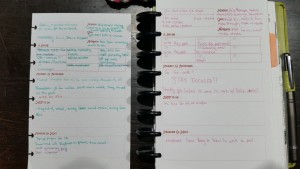
Look at me!!! I’m cute and happy!
Part 1 was all about mindset, part two was about the prework you need to get going. Now, part three is going to cover the hardest part of all: The day to task list. If you’re anything like my clients (or myself), you know that this is the absolute worst. You can go into a project you are truly fired up about, guns drawn and blazing and then….
SQUIRREL!
Where did the day go?!
Yeah, we’ve all been there. It’s fun, right? I’m not going to lie, distraction is one of my favourite things, which is why I don’t let it happen out of controlled experiments. Remember the discipline we talked about in part one? That discipline is a daily struggle with everyone I know that has ADHD, unmedicated or not. You’ll get used to it, develop your own combat strategies against it, and get past it — IF you work at it daily. Which is where we are at now.
The first thing you need to do is find a system that works for you. Not someone else, but for you. This usually means taking someone’s tools and tweaking them over and over again until they look nothing like the originals you had. It also usually means trying out a few different tools and using the best of each one to build your own Franken-tool.
There are a few key features that will work for anyone with ADHD, though. You should look for:
- Flexibility
- Down time
- Timers
- Exercise time
- Repetition

On the left you have a past day, on the right you’ve got today’s work. On a past day I got overzealous, but today I left a lot of flexibility. (Image keeps auto-rotating without my permission.)
My favourite tool by far that I haven’t had to tweak too much has been Owner Media’s daily plan (which is part of their Work Like You’re On Vacation). It has a place for you to put wins, your mission and how you are going to achieve it, a box for a measurable, and 9 individual boxes for timed tasks. To the left is an image of my tweaked version, but it’s missing a few key features that may be helpful to you: A reminder to use your calendar, a reminder to review your mantras and inspiration, and reminder to review how your tasks are aligned with your goals and mantras. I took them out because I use a junior sized day planner that I carry with me everywhere, and I needed precious space. The other bits were more important to me.
What I like about this is that when you fill it out daily you remind yourself what your big picture goals are in the mission, goal, and give yourself an actionable in the approach. You write down wins for good, warm fuzzy feelings that help keep you motivated. You’re reminded to keep yourself aligned with those bits that I took out (but for me they are habit). You are reminded of mindset and tell yourself what NOT to do, and finally you remind yourself to look at what you are measuring and jot down a next goal.
What not to do is just as important as what to do, you know.
Most of the time you are thinking about what has to be done. Take a quick look at your to-do list. What comes to mind?
Mine frankly makes me want to run back to bed and pull the covers over my head.
However, every day I fill out the not to do with a habit I’m trying to break. Recently it’s staying out of my email. I could seriously get lost in there for hours. Yours might be Facebook, Pinterest, or any of the other social medias of the day. Sure, they are fun, but they don’t get the work done. Thus is important to limit so you can get the real work done.
Measuring is important.
How do you know what you’re slaving away over is working if you don’t measure? Here at Insanitek we are still experimenting with different measurements. Lately, we’ve been obsessed with online engagement, which means looking at comments, opens and replies to newsletters, & replies to social media. We get lots of action in meat space, but online seems to be a bit nebulous to us, hence the measuring to see if what we’re doing is working.
We are also always measuring how long it takes us to do something, so timing is very, very important. Sure, we can spend hours on a blog post, but what good does it do if it’s not getting engagement? So, we look at how we spend our time, how it measures up, and then adjust accordingly.
Giving yourself a time constraint is important.

Look at my widgets! Calendar at a glance, timer, and countdown to play time.
Parkinson’s Law says that when you give yourself a task, it will expand to the time you give it. So, if you give yourself 2 hours to write that blog post, you’d better believe it will take you 2 hours. You’ll think, “Hey, I’ve got two hours to do this, so I’m just going to…” SQUIRREL! The next thing you know, 2 hours have passed.
So, say you’re going to sit down to write the ubiquitous blog post. Set down with two timers: one that has a countdown, and one that has a count up. I use Chrome with FVD Speed Dial, so I use widget extensions that do both. One timer is to let you know when time on the task is up. Set it for how long you can focus. 20 minutes? 30 minutes? Then, go.
The second timer is to tell you how long it really takes you do to a specific task. You need to know this number so you’re not deluding yourself when you plan your day. I thought it would take me 60 minutes to write this blog post. I was wrong. As of the this, it has taken me 36m 50s. Whew! That means I’ll be able to use that extra 20 minutes elsewhere in celebration. Maybe I’ll go stare at the pond for a while… (FYI: it took exactly 58m 38s for me to finish the post, pictures and all.)
Obviously, there are a million ways to help yourself focus. There are thousands of tools out there on just as many websites. What are your favourites? What do you like or not like about them? How did you make them your own?







